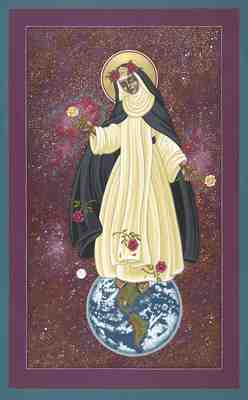Sale on canvas prints! Use code ABCXYZ at checkout for a special discount!

Santa Rosa of Lima, Patroness of the Americas
Rosa of Lima (1586–1617) is often called the patroness of America because she was the first saint to be canonized in the Americas (1671). Her feast day is August 23. Rose is a beloved saint among Spanish- speaking people, especially in New Mexico. The city of Santa Rosa is located a couple hours drive east of Albuquerque .
As a young woman, upon discovering the life of Catherine of Siena (1347–1380), Rose sought to emulate her. As a result, she became a lay Dominican. She was known for her rigorous practices of asceticism and penance, much to the dismay of her family and loved ones. Even today the reality of her religious practices make people uncomfortable. Such concern prompted the famous theologian Hans Urs Von Balthasar to ask the mystic Adrienne Von Speyr about her practices. Drawing on the authority of her mystical experience, Von Speyr informed him that Rosa’s practices were fine because her intentions were out of love for God.
We must keep a couple of things in mind with respect to her austere practices. First, Rosa would use her penances for the sake of others who were suffering. Those people that Rosa would intercede for— the ones she would literally suffer for— would often be healed. In this way she was similar to a bodhisattva or shamanic healer. Second, there is a sense in which great saints are often extreme in some aspects of their lives. This does not necessarily mean that others should literally emulate the kinds of practices they carry out. Shortly after the death of St. Francis, for example, the pope forbade the Franciscans to subscribe to the saint’s rigorous interpretation and practice of poverty.
Bill had conceived this image of Santa Rosa for several years before actually completing it. A labor of love, when he finally completed the piece he was not sure what to do with it. Tragically, the events of Sandy Hook Elementary School and the brutal murder of the twenty children and six teachers and staff in Newtown, Connecticut, occurred on December 14, 2012. This would provide an opportunity. On this point, I would like to share a personal anecdote. Shortly after the murders in Newtown, I had a dream that there was a statue of St. Rosa in my living room. The front of the statue was covered with green vomit, as if St. Rosa had puked on the front of her habit. I interpreted this as a visceral response to the ugly violence that had occurred in Newtown. I relayed this dream to Bill because of his devotion to St. Rosa and because I knew he was deeply upset by the murders as well. Unbeknown to Bill or myself at the time, the Catholic parish in Newtown was named St. Rose Parish. Upon learning this fact, Bill immediately sent the icon of St. Rosa to the parish in Connecticut in the hopes that it might assist as a healing image for the members of the community.
In the image St. Rosa stands on the earth in her Dominican habit with her feet on the northern part of the Americas, though she is the patroness of both continents. Given that this icon was completed prior to the events in Newtown, it is perhaps prophetic that her left foot is close to that region of New England. The rose stems and petals of her intercession fall gently upon the planet. The light of the moon, an image of the Mother of God, is near. The soft hue of rose permeates the picture, providing a healing and contrasting image to the red blood of violence.
Why is she situated in the cosmos? Perhaps this offers a more expansive view, lifting the people up and giving a larger view of life. Is there life on other planets? If so, do those beings face the brutality of violence, or are they perhaps living in harmony? When we are in grief and pain it is always helpful try to take on a larger view. In his anguish of losing everything Job complained to God, and God responded by asking if he was there when the stars were made (Job 39:3). In the wake of the murders in Newtown we are faced with deeply disturbing realities. Often such anguishing questions, like Job’s anguish, remain unanswered. The intercession of Rosa of Lima and the image she provides offer the hope of healing and transformation for our world.
John Dadosky
Image to Insight